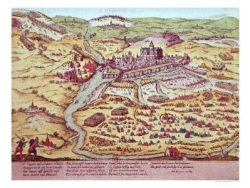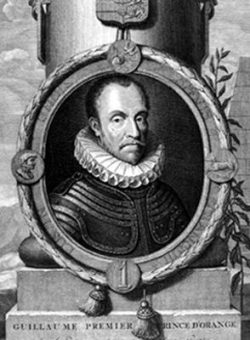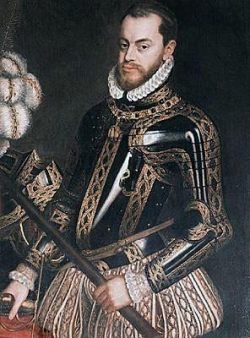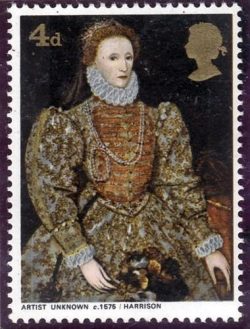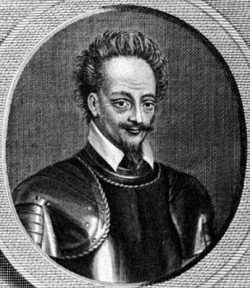The foreign war
Foreign intervention in the French civil war is one of the permanent features of the wars of Religion. It is indeed difficult to make a clear cut between civil war and foreign conflict. France is the region where European rivalries confront one another through intervening parties.
From the early 16th century
The struggle started in the 16th century between the French and the Spanish for supremacy in western Europe and went on until 1559. France, weakened by the defeats at Saint-Quentin in 1557 and Gravelines in 1558, signed the Cateau-Cambrésis treaty with Spain on 3 April, 1559. It put an end to the Italian adventure. France had to give back to the duke emmanuel-Philibert de Savoie, then allied with Spain, the last strongholds in the Piedmont, Charolais, Bugey and Bresse regions. He was also to give up his claim on the Franche-Comté region. Elisabeth, henri II’s daughter was married to Philip II and Marguerite, the king’s sister, to the Duke of Savoie. The treaty also showed the unity of the two powers against the heresy.
The English part of the treaty with the young queen Elizabeth I settled the problem of Calais, which was to remain French for a large amount of money
War with Spain
The Spain of Philip II became the first power in Europe. Philip II’s main goal was to establish his sovereignty over the Netherlands and to destroy the naval power of the English who threatened his possessions in Santo Domingo, Cuba and the Azores.
The Netherlands, part of the Spanish Empire, had become Protestant, repression -over 300 executions between 1532 and 1566 – caused the population’s uprising and the opponents were called “Gueux”. The repression increased, on Philip II’s order, implemented by the Duke of Albes after 1567, and caused indignation. A special law court, the council for unrest, decided on a thousand death penalties and eleven banishments. It went after the aristocracy, sentenced to death counts Egmont and de Hornes, and two Catholic noblemen in favour of tolerance. The prince of Orange, William of Nassau, converted to Protestantism, made a mutual assistance deal with Henri de Condé and Gaspard de Coligny. He took part in battles in France, and his brother Louis de Nassau, a convinced Calvinist, attended the synod in La Rochelle in 1571. Gaspard de Coligny tried to convince Marie de Medicis to support the rebels, but seeing the size of the Spanish armies -their fleet won the battle in Lépante against the Turks on 7 October 1571 – the regent rejected his advice.
Thanks to the gold from American conquests, the financial power of Spain was considerable. It enabled her to bribe the princes, to pay for armies, to keep a network of agents and spies who were very active with the leaguers. The deeply indebted Duke Henri de Guise was given large sums of money.
Philip II was worried about the relationship between Henri III and the rebels in the Netherlands. The king of Spain was the landlord of Cambrai annexed to France by a parliamentary decree at the beginning of 1585. In the treaty of Joinville on 17 January 1585 Philip II agreed to defend Cardinal de Bourbon’s claim to the throne of France and to fund his party up to 600,000 crowns. In return the leaguers promised to eradicate Protestantism, to implement the decrees of the Council of Trente in the whole kingdom, and to support the struggle of the Spanish in the Netherlands. Philip II promoted the election of Pope Sixte-Quint in September 1585, who immediately condemned Henri de Navarre and denied him any claim to the throne.
During the siege of Paris, Spanish envoys boosted the morale of the defenders. The army of Alexandre Farnèse temporarily raised the siege in August 1590, then his troops went back to the Flanders. Spanish back up supported the Duke of Mercoeur, master of Brittany, and the Duke of Joyeuse in Provence. All peripheral provinces, Savoie and Lorraine, were won over thanks to the Spanish gold, encouraging secession tendencies.
At the general assembly of the League in January 1593, the Spanish suggested choosing infanta Isabella, the daughter of Philip II and Elisabeth of Valois, grand-daughter of Henri II and Catherine de Medicis. In return, they promised Burgundy and Picardie to the duke of Mayenne, lieutenant-general of the League. The proposal was rejected.
The Duke of Mercoeur was still opposed to Henri IV thanks to Spanish support. He arranged several treaties with Philip II in which he acknowledged Isabella as queen of France.
War with England
England then paid very much attention to what was happening in France. It feared the Spanish would use harbours in the Netherlands to attack English ones. It was afraid that the Spanish fleet would threaten its naval superiority, and even its territory – as the Invincible Armada had. It was won over to the Reformation, and sent money and troops to the Huguenot party as early as the first war of Religion. The Hampton-Court treaty of 20 September 1562 stipulated it would send money and troops, and Henri de Condé accepted to give away a harbour on the Channel. Expeditionary forces, 6,000 men strong, disembarked at Le Havre. In August 1568 during the third war of Religion, Henri de Condé and Gaspard de Coligny signed a new alliance with Elizabeth I to finance the expedition of the Palatine count Wolfgang, Duke of Deux-Ponts, to Burgundy in the Spring of 1569.
War with German principalities
The German Calvinist princes were to intervene. Henri de Condé got support from the landgrave Philip of Hesse. Another Calvinist, Palatine Count Frederic III, a Lutheran who had turned Calvinist, took part in the Protestant struggles. During the second war of Religion he sent about 10,000 thuggish soldiers to France via Lorraine. His son, Jean-Casimir, a convinced Calvinist, went into France with 4,000 cavalry. His troops joined those of the Duke of Alençon.
Finally, mercenaries from all over Europe were recruited: English, German and “Albanians” for the Protestants, Italian and Spanish for the royal, Swiss for both parties.
Bibliography
- Books
- COTTRET Bernard, 1598, L’édit de Nantes, Perrin, Paris, 1997
- GARRISSON Janine, Henri IV, Le Seuil, rééd. 2008, Paris, 1984
- MIQUEL Pierre, Les Guerres de religion, Fayard, Paris, 1980
Associated tours
-
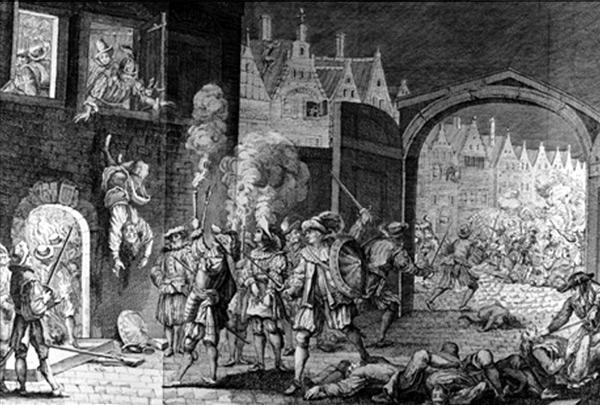
The eight wars of religion in detail
The wars lasted thirty-six years. The kingdom of France had 18 million inhabitants at that time – indeed, few other European countries had as many. The growth rate rose considerably...

